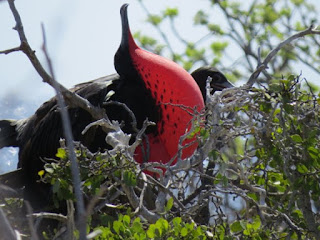This is the second part of Margriet's story of her visit to the Galapagos Islands. Click here for the first part.
 |
| Blue-footed Boobie! |
We hiked across Mosquera Islet seeing many birds up close, including – to my delight – the Blue-footed Boobie. We had watched documentaries about the Galapagos and were thrilled to see these birds in real life, as well as the bright red Sally Lightfoot Crabs scurrying across the black lava rocks, pelicans, swallowtail gulls, and many others.
 |
| Male Frigate Bird |
But this is a National Park and everything is highly protected. You cannot take a rock or a shell or touch anything. And rightly so.
Next we hiked North Seymour Island where the huge Frigate Birds soared overhead and young ones with white heads in perched in trees, looking like bald eagles.
Iguanas live on most islands but they are different species, having adapted to life on each island. Some islands had black iguanas; elsewhere they were yellow or even pink. We also saw the swimming ocean iguanas.
We hiked across Santa Fe and South Plaza islands. Being on a boat allowed us to visit more places but it also had the disadvantage of rocking and bobbing.
However, the biggest thrill for me was being able to swim off the back of the boat. Even after a few excited calls of “Shark!” I couldn’t figure out why it was okay to swim when there were sharks, but I trusted that our guides knew what they were doing.
We snorkeled several times, and it was beyond description to be in the ocean and have a large sea lion coming straight at me like a bullet, only to veer off at the last second. At one point two sea lions swam alongside me on either side. I watched turtles swimming below me, and hundreds and hundreds of colourful fishes like parrot fish.
And sharks. White tip sharks. Pretty cool.
On San Cristobal Island we strolled through the town and it was a bizarre experience to run into two friends from Kelowna!
We visited the Galapagos Interpretation Center. Sweat dripped of our bodies as we just stood still, reading about the violent human history on the islands. The animals really ought to be afraid of humans. They killed over 100,000 turtles and thousands of whales during the mid-1800s to mid-1900s. Nowadays, 97% of the islands is strictly protected as a National Park. All we can do is hope it will always stay this way and that Galapagos’s amazing variety of wildlife, which so well demonstrates its capacity to change and adapt to its natural environment, will be around for generations to come.
Reflecting back on it all, I am very glad to have been able to make this amazing trip and to see these special places on Earth. But it is a very long way to travel, expensive, and a bit overrated. Like ‘Serengeti’ the name ‘Galapagos’ has mysterious allure, but we have visited many places where plants and wildlife have adapted to their environment, and places like Australia’s Great Barrier Reef where we also saw giant tortoises and birds that stayed a foot away from us.
If you can go, do it. But otherwise, savour nature around you anywhere – nature is always incredible and forever adapting.
All photos are Copyright ©Margriet Ruurs




No comments:
Post a Comment